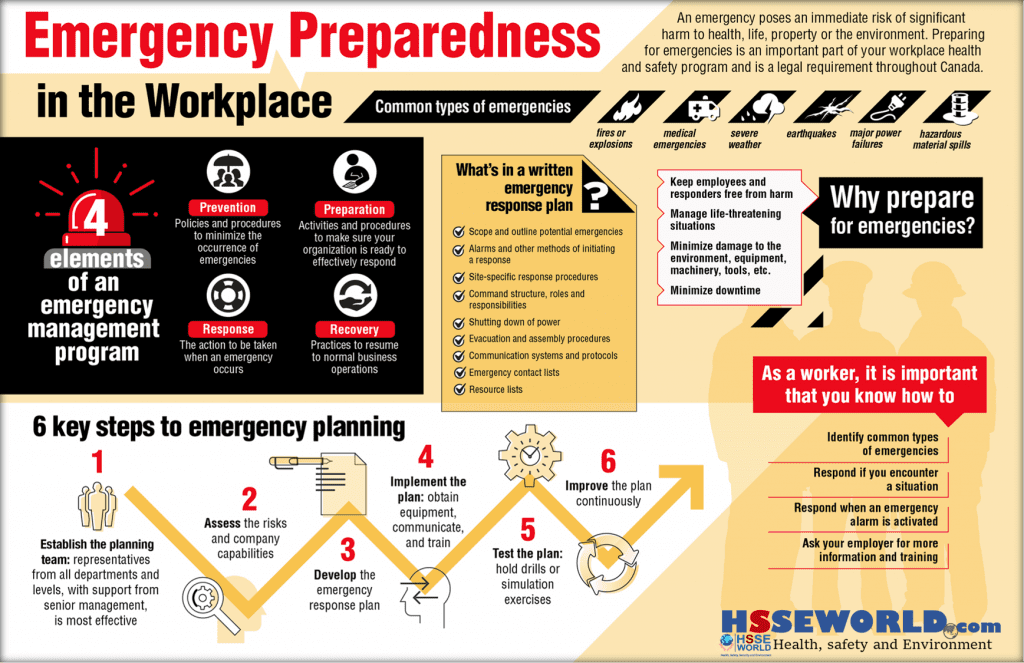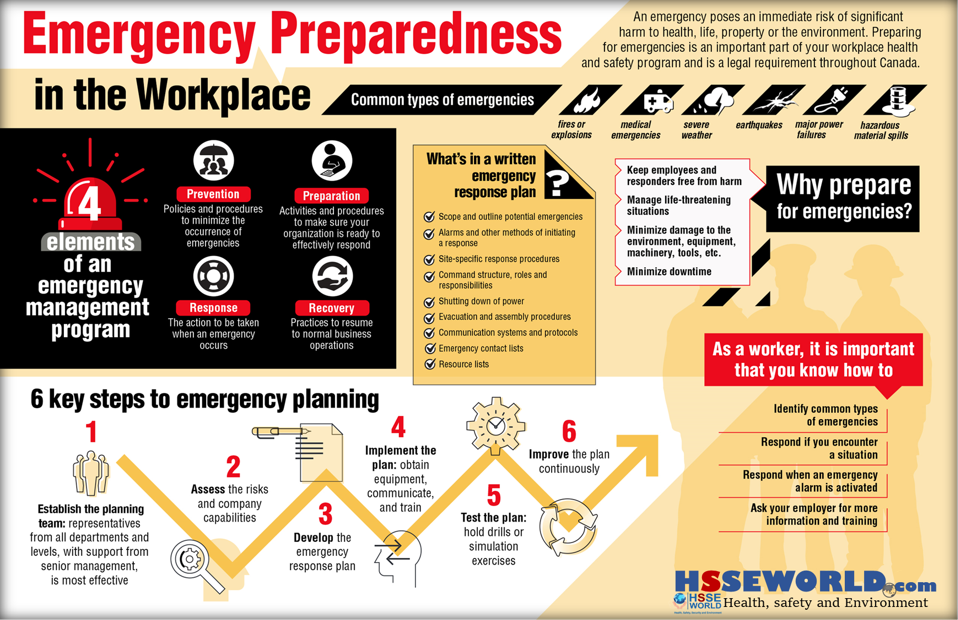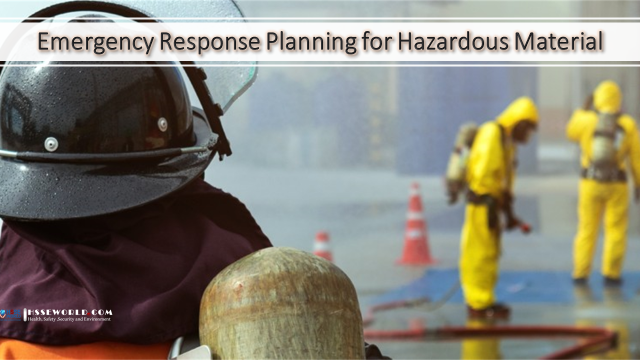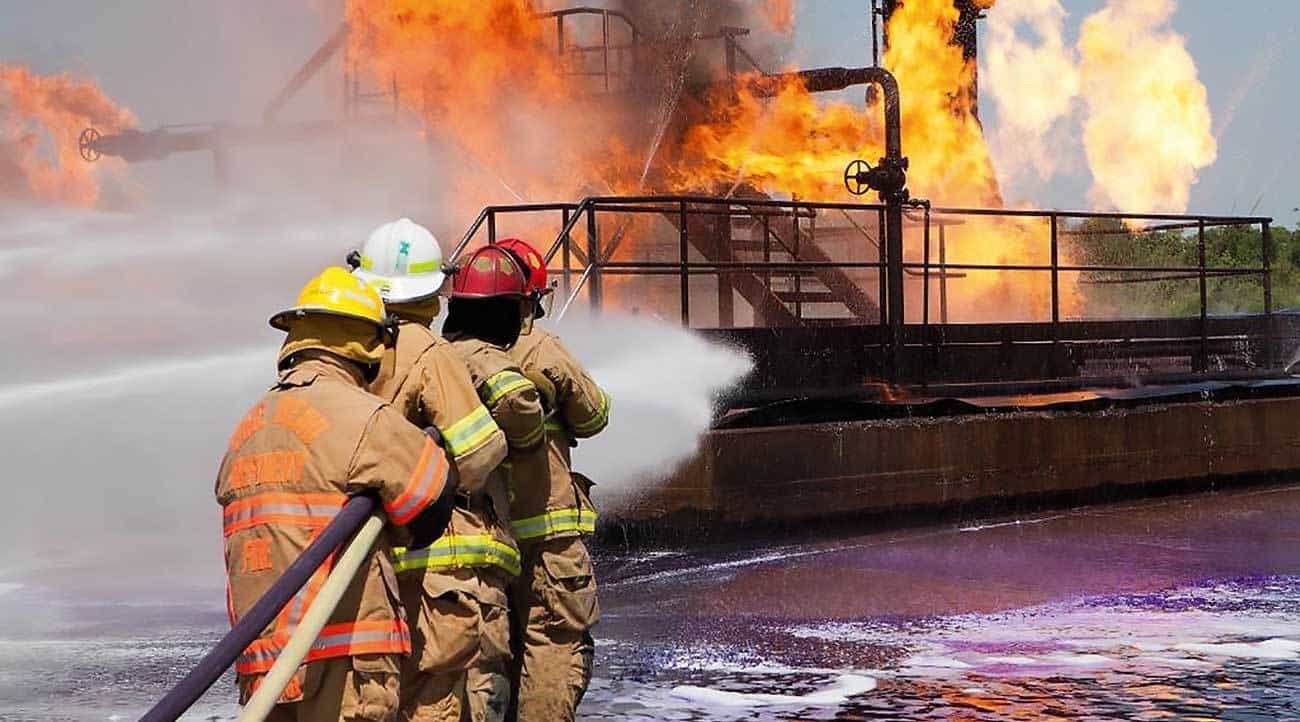Emergencies and disasters can strike anywhere and at any time bringing workplace injuries and illnesses with them. Employers and workers may be required to deal with an emergency when it is least expected and proper planning before an emergency is necessary to respond effectively.
This photo of the day is designed to help workers and employers plan for that possibility. The best way to protect workers is to expect the unexpected and to carefully develop an emergency action plan to guide everyone in the workplace when immediate action is necessary. Planning in advance helps ensure that everyone knows what to do when an emergency occurs.

What is a workplace emergency?
A workplace emergency is a situation that threatens workers, customers, or the public; disrupts or shuts down operations; or causes physical or environmental damage. Emergencies may be natural or man-made and may include hurricanes, tornadoes, earthquakes, floods, wildfires, winter weather, chemical spills or releases, disease outbreaks, releases of biological agents, explosions involving nuclear or radiological sources, and many other hazards. Many types of emergencies can be anticipated in the planning process, which can help employers and workers plan for other unpredictable situations.
The Emergency Preparedness and Response landing page provide a listing of all of the specific hazards for which the Agency currently has information available on its website, as well as links to general emergency preparedness and response guidance.
2020 has been an unpredictable year for businesses. With the emergence of the COVID-19 pandemic, business owners and employers have embraced a new normal and are implementing strategies to protect workers and consumers against infection. This year, some world areas have faced additional hazards, including wildfires, hurricanes, tropical storms, and tornados. What businesses can take away from such an unpredictable and devastating turn of events this year is to have a plan in place for when emergencies and disasters strike.
It may seem challenging to determine what it means to be “prepared” when it seems that each day presents the possibility of new hazards occurring on the job. However, there are concrete steps business owners and employers can take to ensure that when the unexpected occurs, the response can be quick, efficient, and not compromised by confusion. As we recently honored National Preparedness Month, which is recognized each September to promote family and community disaster and emergency planning, it serves as a reminder to acknowledge the importance of being prepared for all emergencies.
Hazards
In order to prepare for the unpredictable and unprecedented, employers and those in managerial positions should evaluate potential risks and determine which, if any, disasters and hazards may cause a potential threat to their workplace and the safety of their staff. This can include natural hazards such as floods, tornadoes, and earthquakes, health hazards, including localized illnesses and global disease outbreaks such as COVID-19, as well as human-caused hazards like workplace accidents.
Once the risk factors have been identified, make sure to sign up for local warnings and alerts to receive news notifications so you can respond in a timely manner and alert staff and co-workers. The next step is to create an effective, tailored plan for each potential disaster or event, including an emergency action plan (EAP) that organizes employer and worker actions during emergencies and addresses specific worksite layouts, emergency systems, and structural features. Some employers are required to have an EAP by the Occupational Safety and Health Administration (OSHA); however, it is recommended for all workplace environments.
Workplace Preparedness Plans
Although it is often overlooked, the workplace can be one of the most effective environments for encouraging and educating people on disaster preparedness. According to the Federal Emergency Management Agency, employees who were encouraged by their employer to have a plan were 76% more likely to do so, and employees encouraged to participate in training were 86% more likely to do so.
Although emergencies can strike at any time, many can be anticipated with thorough research. Thorough workplace preparedness emergency plans should consider employee safety procedures—particularly in the event of last-minute emergencies—contingency plans to deal with workplace damages, personnel equipment, any evacuation procedures and establish a chain of command.
According to OSHA, an effective workplace emergency plan should:
- Remain personnel-focused, including clear communication about what to do during and after the disaster. The primary goals of the plan are protecting lives and property in an emergency.
- Give concise instructions and methods for reporting hazards and emergencies.
- Include evacuation procedures, emergency escape routes, and consider any hazards within the workspace
- Outline the rescue and medical duties for designated workers
- Include contact information for individuals inside and outside the company who can be contacted for further details on the responsibilities and duties contained within the emergency plan
- List procedures for the employees who must remain within the worksite for essential work functions
As part of the planning process, employers should consult with local health agencies and public safety authorities on any plans and ensure regulations are adhered to. All staff should receive training on emergency preparedness to ensure they are knowledgeable about any plans in place. Company drill exercises are a useful tool to ensure employee engagement in this area. All escape routes, evacuation procedures, safety personnel contacts, and emergency contact information should be established and effectively communicated to staff, along with the final plans.
It is also important to note that workplace emergencies are not limited to natural disasters or accidents that cause physical damage. COVID-19 is but the most recent example of a health hazard. Thus, it is vital to revise any existing plans based on the Centers for Disease Control (CDC) recommendations due to COVID-19 and any additional workplace safety procedures.
Steps To Take If An On-The-Job Injury Occurs
If an emergency does occur and a workplace injury takes place, it is vital to remain calm, call 911, and seek medical attention for the injured individual. Injured persons should have their ailments properly evaluated, documented, and treated by a medical professional as soon as possible.
Following the treatment of injuries, workers should file an accident report and file a workers’ compensation claim. In most instances, employees cannot sue their employers for injuries or illnesses that occur in the workplace. Workers can file a claim under their state’s workers’ compensation law to recover losses, including lost wages, total and partial disability, medical bills, and wrongful death benefits. Regardless of whether the injury or illness was the fault of the worker or employer, coverage can still be provided, as negligence does not determine whether workers’ compensation benefits can be provided.
For those who suffer an accident or injury or lose a loved one due to the negligence of a third-party person or entity, outside of an employer, victims may secure compensation for losses due to their injuries through a personal injury lawsuit. Damages awarded in personal injury cases are provided to make victims “whole,” and can include compensation for medical expenses, lost income, future wages or diminished earning potential, physical pain and suffering, as well as mental anguish, lost quality of life, and other emotional injuries. Injured workers looking to pursue legal recourse for damages they have suffered due to negligence should seek out an experienced personal injury lawyer who can advise them of their legal rights and remedies.
This year has demonstrated the importance of having a preparedness plan for unexpected hazards. Having a proper plan in place for when these events occur can help save time and protect employees. For this reason, employers should establish comprehensive safety procedures and take measures to help protect staff from disasters and workplace injuries.
(read more: what-is-an-emergency-management-plan-and-what-should-be-included-in-it/)




